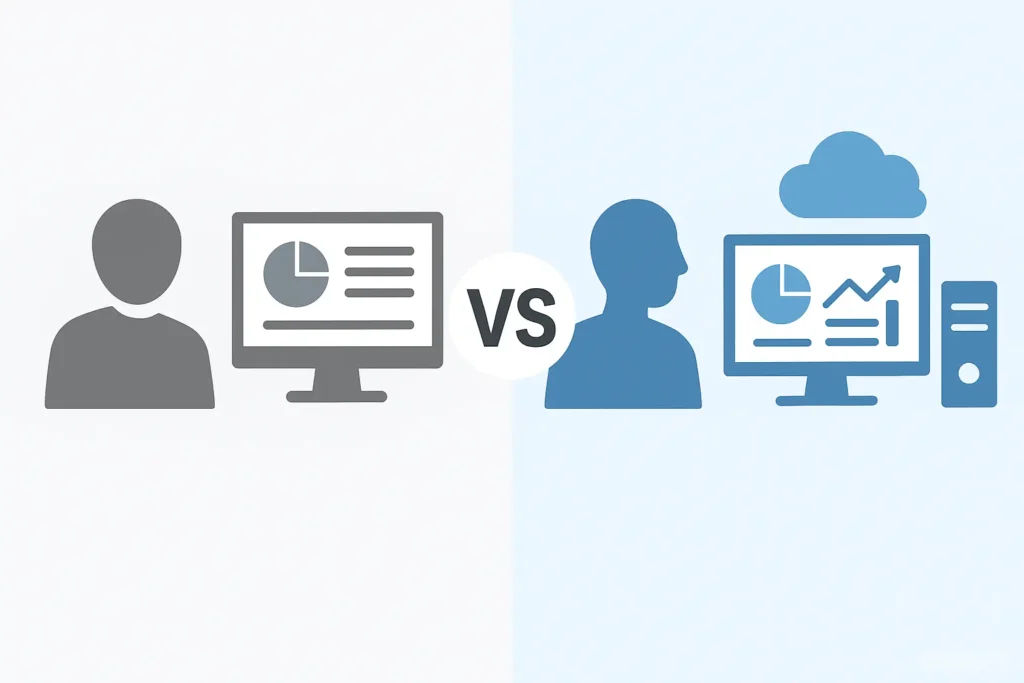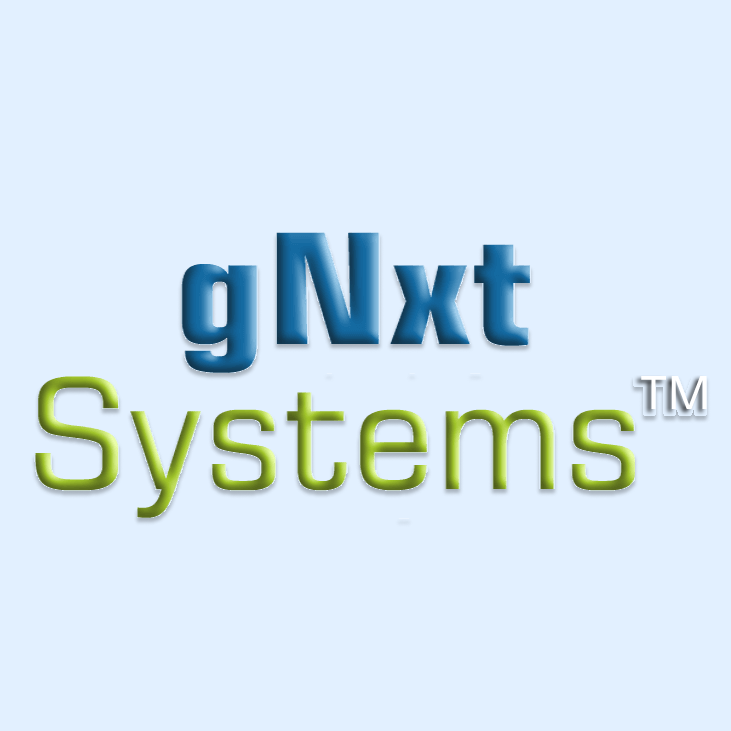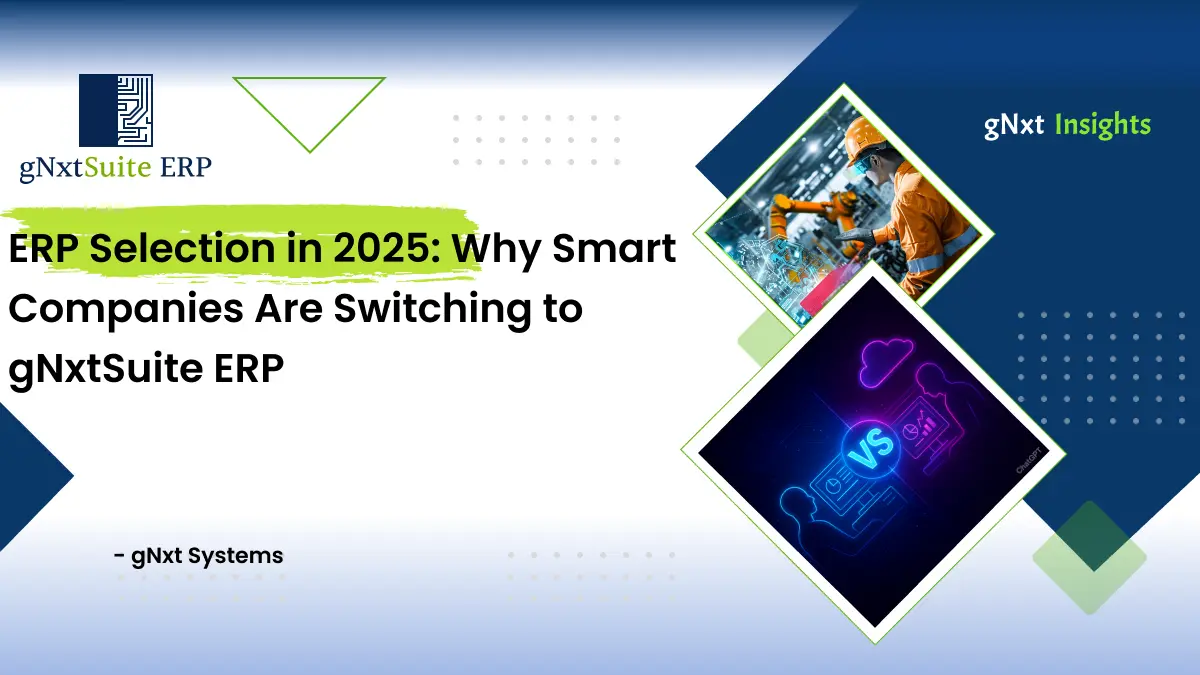- September 29, 2025
- by gNxt Systems
ERP Selection in 2025: Why Smart Companies Are Switching to gNxtSuite ERP
In the rapidly evolving landscape of enterprise software, 2025 is shaping up to be a pivotal year for companies reconsidering their ERP (Enterprise Resource Planning) strategy. As trends like AI-powered ERP, real-time data insights, cloud-first architectures, and flexible integration modules become table stakes, businesses are increasingly evaluating next-generation ERP suites rather than tweaking legacy systems. One such next-gen solution gaining traction is gNxtSuite.
This article explores the current ERP selection trends in 2025, what companies are demanding, and why gNxtSuite is emerging as a preferred choice. We’ll also include a data-driven comparison and actionable guidance.
Key ERP Trends & Buyer Priorities in 2025

Before digging into gNxtSuite, let’s understand what smart companies are looking for in their ERP systems this year:
| Trend | Why It Matters | Supporting Data / Insights |
|---|---|---|
| AI-Powered ERP | Instead of being just transactional, ERP platforms now leverage AI to offer predictive analytics, intelligent decision support, process optimization, and anomaly detection. | Industry reports indicate that AI-powered ERP is cited among the top 3 ERP trends in 2025. |
| Cloud-First / SaaS & Hybrid Deployments | Offers scalability, lower upfront infrastructure cost, continuous updates, remote accessibility. | Many companies are migrating from on-premises/closed systems into cloud or hybrid ERP platforms. |
| Real-Time Data & Embedded Analytics / BI | Decision-making requires up-to-date dashboards, KPIs, visibility across supply chain, finance, HR etc. | Embedded analytics is a top trend; real-time data visibility improves responsiveness and ROI. |
| Modular / Composable Architecture | Companies want the flexibility to pick and choose modules (finance, manufacturing, SCM, HR etc.), add on integrations or custom modules. | Composable ERP and “industry-specific ERP solutions” are increasingly in demand. |
| Heightened Security, Compliance & ESG / Sustainability | As data regulations, environmental and governance norms tighten globally, ERPs must support compliance, traceability, auditability. | Security, ESG, and sustainable systems are trending priorities. |
| User Experience (UX), Mobile Access, Voice / Conversational Interfaces | To boost adoption, reduce training, support remote/field operations, and reduce friction for non-technical users. | Mobile ERP advances and enhanced UX are among the top 10-11 trends. |
Why Many Companies Are Moving Away from Legacy or Generic ERP
Here are common pain points that push companies to switch:
- Legacy/on-prem systems lack agility; upgrades are costly and slow.
- Customizations become technical debt, making future upgrades harder.
- Poor integration with newer tools (CRM, e-commerce, analytics) leads to data silos.
- Lack of real-time visibility; decision-making lags.
- Limited mobile or field-friendly capabilities.
- Security vulnerabilities or compliance gaps, especially with newer data/privacy laws or ESG expectations.
Introducing gNxtSuite ERP: What It Offers & Why It Aligns with 2025 Needs
Here’s what makes gNxtSuite ERP stand out and why forward-thinking companies are choosing it:
AI-Powered ERP Intelligence
gNxtSuite integrates artificial intelligence into its ERP core — enabling predictive forecasting, smarter insights, anomaly detection, and intelligent recommendations that help leadership teams act faster and with greater confidence.Modular, Composable Architecture
gNxtSuite is designed so that companies can start with core modules (Finance, Inventory, HR) and then incrementally add Specialized SCM, Manufacturing, Analytics, etc. This avoids overpaying for unused modules and keeps the system agile.Cloud-Native & Hybrid Deployment Options
Whether a business wants entirely in the cloud, or a hybrid model (some on-premises, some cloud), gNxtSuite supports both, enabling smooth scaling, easier updates, and resilience.Real-Time Dashboards & KPI Monitoring
With live data streams across finance, supply chain, production, and CRM, decision makers can see what is happening now — not just what happened last month. This increases responsiveness to market or supply disruptions.Strong Security, Compliance & Traceability
End-to-end data encryption, clear audit trails, configurable compliance modules (for ISO, GDPR, local tax & statutory norms), plus sustainability reporting features to support ESG goals.Excellent UX / Mobile Access / Field-Friendly Interfaces
Designed with intuitive interfaces, mobile apps, possibly voice or conversational assistants (chat or voice commands) for routine tasks (e.g. approvals, inventory scanning). Reduces training overhead, increases adoption especially for field, remote or distributed teams.Integration-Friendly & Open API / iPaaS Compatibility
Ability to integrate with other best-in-class tools: CRM, ecommerce, warehouse management, manufacturing execution systems etc., via APIs or connectors. Helps avoid data silos.Cost-Effective Total Cost of Ownership (TCO)
Because of modular deployment, cloud hosting, lower customization and maintenance overhead, companies report faster ROI and lower long-term costs.
Data-Driven Case Comparison: gNxtSuite vs Legacy ERP Alternatives

| Metric | Legacy / Generic ERP | gNxtSuite ERP |
|---|---|---|
| Implementation Time | Often 12-24 months or more for full deployment, heavy customization | Modular rollout in phases; core modules live in a few months; enhancements added over time |
| Upgrade / Maintenance Costs | High; custom addons break with version upgrades; frequent patch lag | Managed updates in cloud; minimal custom-breakage; predictable maintenance schedule |
| Operational Efficiency Gains | Moderate; often constrained by siloed modules, manual data entry | Higher; AI-powered ERP, real-time data help reduce manual tasks, errors, and lead times |
| Scalability | Difficult; scaling often requires re-architecture or new hardware/software | Built to scale; cloud/hybrid allows scale in users, geographies, modules easily |
| User Adoption & Experience | Often low; complex UI, training overhead, slower adaptation in field roles | More intuitive UI, mobile and possibly conversational tools boost adoption |
| Security & Compliance Risk | Higher risks especially as systems age; harder to adapt to changing regulations | Lower risk; modern security protocols, compliance modules, traceability built-in |
Who Benefits Most from gNxtSuite ERP
- Mid-sized to large enterprises seeking to overhaul outdated, fragmented ERP systems.
- Companies with multiple locations or international operations needing compliance across jurisdictions.
- Industries with complex supply chain, manufacturing or heavy logistics (e.g. manufacturing, distribution, retail, pharma).
- Organizations focused on ESG, audit, traceability, sustainability reporting.
- Companies aiming to digitally transform, reduce manual overhead, and be responsive to real-time market changes.
Challenges to Be Aware Of & Mitigation
No ERP selection is without challenges. Here are what to watch out for and how gNxtSuite helps or what companies should plan for:
| Challenge | Mitigation / How gNxtSuite (or the implementing company) Can Address It |
|---|---|
| Resistance to change / user adoption | Design UI with user experience in mind; phased rollout; training & support; mobile/field-friendly tools |
| Data migration & legacy customisations | Plan data migration carefully; cleanse data; limit custom code; adapt processes to system standard where feasible |
| Integration with existing third-party systems | Use robust APIs, connectors; ensure middleware or iPaaS tools are available; plan integration strategy up front |
| Regulatory & localisation issues | Deploy compliance modules; configure statutory norms; use modular localised features; option for local data storage or hybrid cloud if required |
| Upfront investment vs payback uncertainty | Use proof-of-concept or pilot; model costs vs benefits; start with high-ROI modules; monitor KPIs regularly |
Why 2025 Is a Tipping Point — Not Just a Year
- Rapid innovation in AI-powered ERP: Features that were niche are now core expectations. Buyers expect predictive analytics, intelligent recommendations, and smarter decision support.
- Cloud maturity: Cloud-native / hybrid deployment is now stable, secure, and proven; fewer excuses to stay on legacy on-prem only.
- Regulatory & ESG pressure: Governments, investors, customers demand transparency, traceability, sustainability. ERP systems must support that.
- Market volatility & supply chain shocks: Real-time visibility, agility, scenario planning are essential. Companies with rigid systems suffer more.
- User expectations: With consumer apps, mobile UX, voice assistants, people expect enterprise tools to be usable, fast, mobile.
Therefore, companies delaying ERP modernization risk falling behind in competitiveness, flexibility, and overall cost efficiency.
How to Evaluate & Choose gNxtSuite (vs Other Vendors)
Here’s a selection checklist / decision-matrix you can use when evaluating ERP platforms (including gNxtSuite) in 2025:
Core vs Custom Features: Which modules are must-have? What customisations are unavoidable?
Deployment Model: Cloud, hybrid, on-prem; data residency and privacy compliance.
Scalability & Modularity: Ability to add modules or users without major rework.
AI & Analytics Capabilities: What predictive / ML features are included? Are dashboards real-time?
UX & Mobile / Field Access: Are mobile apps or field-usable features available? Training needed? Intuitive UI?
Security, Compliance & Localisation: Does vendor support local tax, statutory requirements, data laws (e.g. GDPR, India’s privacy laws etc.)?
Integration & APIs: How well does the system connect with CRM, WMS, ecommerce, analytics, etc.? Is there support for iPaaS or middleware?
Total Cost of Ownership: Licensing, setup, implementation, support, upgrades, training.
Vendor Support & Roadmap: Is the vendor innovating (e.g. adding AI, voice, mobile, etc.)? What is the update/maintenance frequency?
Return-on-Investment (ROI) & Payback Time: Pilot or proof-of-concept can help; estimate savings in manual labour, faster cycles, better decision making, risk reduction.
Real-World Outcomes: What Companies Switching to gNxtSuite Can Expect
- 30-45% reduction in manual data entry and reconciliation-heavy tasks.
- 30% faster decision cycles, thanks to real-time, AI-powered ERP dashboards.
- 20-40% lower maintenance / upgrade overhead over legacy systems.
- Improved order-to-cash cycle times by shortening process waits, reducing errors.
- Better compliance and traceability, reducing audit risk, regulatory penalties.
- Higher employee satisfaction and adoption, less friction, lower training costs.
Why Smart Companies Are Already Moving
Companies that delay ERP modernization often face unexpected costs: system downtime, inefficiency, security breaches, opportunity cost. Smart companies are making the switch now — not just to catch up, but to lead. By choosing a modern, modular, AI-powered ERP like gNxtSuite, they are positioning themselves to handle:
- demand volatility
- regulatory complexity
- digital transformation expectations from customers/partners
- remote work / field / mobile operations
- sustainability / ESG pressures
FAQs
Implementation depends on company size and complexity. Smaller businesses can go live with core modules in three to six months, while larger enterprises with multi-country operations may take twelve to eighteen months. Phased deployment ensures faster results and reduced risk.
The platform offers automated tools and structured processes for migrating data from legacy systems. Data cleansing and selective migration ensure accuracy while minimizing disruption, helping businesses transition smoothly without losing critical information.
Yes. It features end-to-end encryption, role-based access controls, and detailed audit trails. gNxtSuite also supports compliance with GDPR, ISO standards, and local tax and statutory requirements, with industry-specific modules for sectors like pharma and finance.
Built to scale, gNxtSuite supports multi-location, multi-currency, and multi-language operations. Companies can start with core modules and add more as they expand, while its cloud-native design ensures seamless scalability without costly re-architecture.
Read this blog by gNxt Systems. It might interest you: What is HyperAutomation?
About Author

gNxt Systems is an IT professional services and product development company that follows Agile and Rapid development methodologies.


